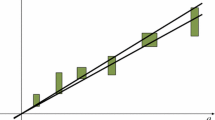Abstract
A balanced model reduction technique that is based on frequency limited interval Gramians is proposed. The technique provides stable models and also yields frequency response error bounds. Numerical examples are also presented. The results are comparable with other frequency limited interval Gramians-based model reduction techniques.








Similar content being viewed by others
References
D. F. Enns, Model reduction with balanced realizations: an error bound and a frequency weighted generalization. in Proceedings of conference on decision and control (1984) pp. 127–132
W. Gawronski, J.-N. Juang, Model reduction in limited time and frequency intervals. Int. J. Syst. Sci. 21(2), 349–376 (1990)
A. Ghafoor, V. Sreeram, A survey/review of frequency-weighted balanced model reduction techniques. J. Dyn. Syst. Meas. Control 130(6), 1–16 (2008)
S. Gugercin, A.C. Antoulas, A survey of model reduction by balanced truncation and some new results. Int. J. Control 77(8), 748–766 (2004)
M. Imran, A. Ghafoor, V. Sreeram, Frequency weighted model order reduction technique and error bounds for discrete time systems. Math. Probl. Eng. 2014, 1–8 (2014)
C.-A. Lin, T.-Y. Chiu, Model reduction via frequency weighted balanced realization. Control Theory Adv. Technol. 8, 341–451 (1992)
B.C. Moore, Principal component analysis in linear systems: controllability, observability, and model reduction. IEEE Trans. Autom. Control 26(1), 17–32 (1981)
R.N. Panda, S.K. Padhy, S. Prasad, S.P. Panigrahi, Reduced complexity dynamic systems using approximate control moments. Circuits Syst. Signal Process. 31(5), 1731–1744 (2012)
J.W.S. Rayleigh, On the character of the complete radiation at a given temperature. Philos. Mag. 27, 460469 (1889)
V. Sreeram, B.D.O. Anderson, A.G. Madievski, New results on frequency weighted balanced reduction technique, in Proceedings of American Control Conference (1995), pp. 4004–4009
D. Tong, W. Zhou, A. Dai, H. Wang, X. Mou, Yuhua Xu, Model reduction for the distillation column linear system. Circuits Syst. Signal Process. 33(10), 3287–3297 (2014)
G. Wang, V. Sreeram, W.Q. Liu, A new frequency weighted balanced truncation method and an error bound. IEEE Trans. Autom. Control 44(9), 1734–1737 (1999)
Q. Wang, Y. Wang, E.Y. Lam, N. Wong, Model order reduction for neutral systems by moment matching. Circuits Syst. Signal Process. 32(3), 1039–1063 (2013)
W. Zhou, D. Tong, H. Lu, Q. Zhong, J.A. Fang, Time-delay dependent \(H_\infty \) model reduction for uncertain stochastic systems: continuous-time case. Circuits Sys. Signal Process. 30(5), 941–961 (2011)
Author information
Authors and Affiliations
Corresponding author
Rights and permissions
About this article
Cite this article
Imran, M., Ghafoor, A. A Frequency Limited Interval Gramians-Based Model Reduction Technique with Error Bounds. Circuits Syst Signal Process 34, 3505–3519 (2015). https://doi.org/10.1007/s00034-015-0031-7
Received:
Revised:
Accepted:
Published:
Issue Date:
DOI: https://doi.org/10.1007/s00034-015-0031-7




